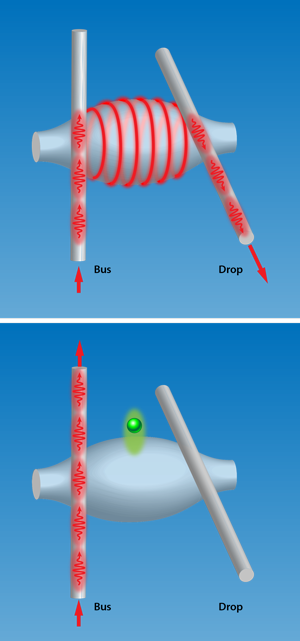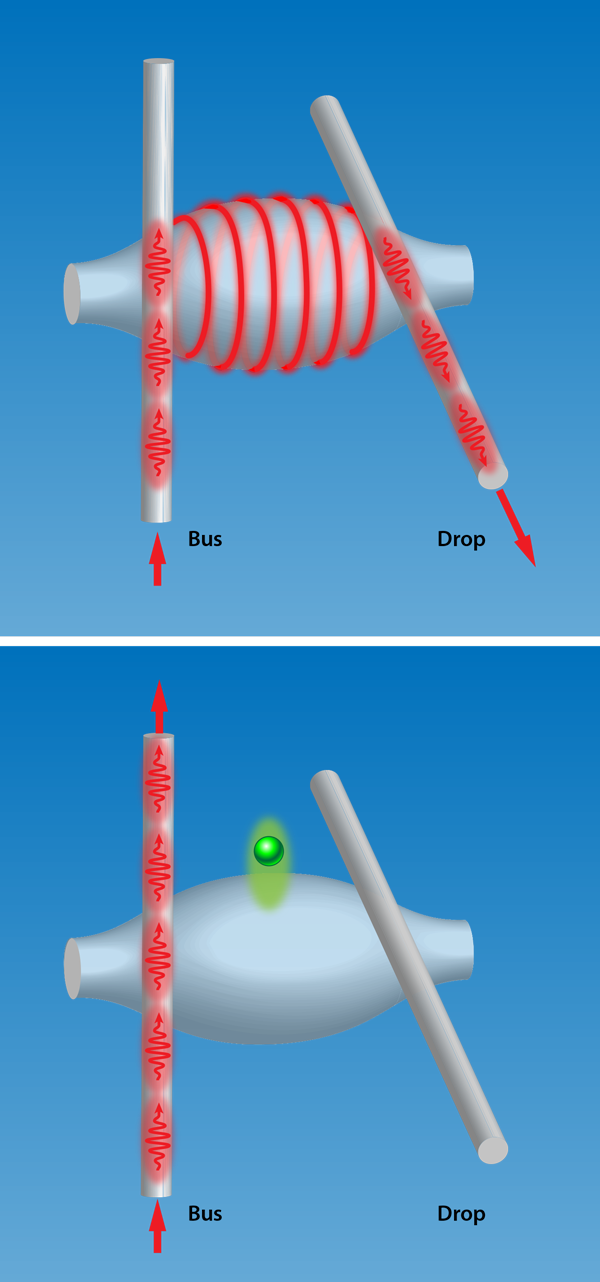A Single-Atom Optical Switch
Quantum scientists over the past two decades have dreamt of realizing powerful new information technologies that exploit the laws of quantum mechanics in their operation. While many approaches are being pursued, a prevailing choice consists of using single atoms and particles of light—single photons—as the fundamental building blocks of these technologies [1]. In this paradigm, one envisions that single atoms naturally act as quantum processors that produce and interface with single photons, while the photons naturally act as wires to carry information between processors. Reporting in Physical Review Letters, researchers at the Vienna University of Technology, Austria, have taken an important step forward in this pursuit, by experimentally demonstrating a microphotonic optical switch that is regulated by just a single atom [2].
Despite the conceptual simplicity, experiments that demonstrate strong, controlled interactions between single atoms and optical photons have proven to be quite difficult to realize. In free space, the interaction probability between a photon in a focused beam and a single atom is normally quite weak. Typically this interaction is enhanced by placing the atom in a high-finesse cavity, taking advantage of the large number of round trips a photon makes between the cavity mirrors. Researchers first achieved strong atom-photon coupling in experiments in which single atoms passed through a macroscopic Fabry-Pérot cavity [3]. There have been some successful efforts to scale up the complexity of these systems, such as by linking two different atomic “processors” in separate Fabry-Pérot cavities through a shared photon [4]. Overall, however, progress remains quite challenging.
An ideal platform for scaling up these quantum atom-light interfaces has to meet several criteria: it needs to be easily reproducible, compatible with conventional optical fiber networks, and exhibit low probability for photon losses. In recent years, a promising solution has emerged by using photonic systems that guide and confine light at the micro- or nanoscale. Rapid improvement in fabrication capabilities for photonic devices and the development of techniques to interface atoms with these systems have led to proof-of-principle experiments to couple individual atoms with whispering gallery mode resonators [5,6] and photonic crystal cavities [7]. Hopefully, this field of quantum photonics, combining atomic physics and photonics, is mature enough that we will see a number of basic quantum devices emerge in the coming years.
Danny O’Shea and his colleagues at the Vienna University of Technology have taken an exciting step. Over the years, the team led by Arno Rauschenbeutel has pioneered techniques to fabricate “bottle” microresonators, which are bulge-shaped fibers made from heating and pulling conventional glass fibers. Light circulates around the bulge of the resonator because of total internal reflection, while also spiraling back and forth between two turning points at the narrow ends of the fiber. These turning points occur at “angular momentum barriers,” where all of the light’s forward momentum (along the axis) is converted to radial momentum (around the axis). The light is “sealed in” extremely well and can circulate tens of thousands of times around the bulge before being lost. The number of wavelengths traversed in one round trip around the device must be an integer number, leading to a set of sharply defined whispering gallery modes. The evanescent field leaks several hundred nanometers out of the glass and into the vacuum, providing an avenue for a nearby atom to talk to the cavity mode. The combination of long photon lifetime and tight spatial confinement can lead to strong coupling between a single atom and cavity photon, as the group demonstrated earlier this year [6].
In this most recent advancement [2], O’Shea and colleagues have used the resonator to create an “add-drop” filter regulated by a single atom. In this configuration, two waveguides, a “drop” fiber and “bus” fiber, are coupled evanescently to the bottle resonator, providing two different ports for light to enter or exit the resonator. By carefully positioning the fibers relative to the resonator, the waveguide couplings are critically tuned, such that an incoming photon in the bus fiber resonantly excites the cavity mode and leaves completely through the drop fiber (see Fig. 1, top). O’Shea et al. demonstrate that just a single atom coupled to the cavity can turn this switch from “on” to “off.” In the experiment, individual rubidium atoms from a nearby cold atom source occasionally fly into and out of the evanescent field of the resonator. During this time interval, the “fly-by” atom causes a large enough shift in the cavity resonance frequency that the critical coupling between the drop and bus fibers is destroyed. In this case, a photon will maintain its propagation in the bus (see Fig 1, bottom). The possibility of tuning the waveguide couplings allows the team to identify and attain the optimal point of operation of this atom-controlled optical switch.
The atom mostly acts in a classical capacity here, much like a small particle whose refractive index perturbs the light circulating in the cavity and modifies its frequency. However, the real interest in an atom-controlled switch is in the possibility of using the quantum nature of the atom. For example, the atom is a highly nonlinear optical element, as it can only scatter or switch single photons at a time. This is already inferred in the present experiment from the timing statistics of photons leaving the drop and bus fibers, and this feature could be exploited to implement quantum logic between single-photon pulses [8].
The authors also propose that it should be feasible to prepare the atom in a quantum superposition of internal states, only one of which can couple to the resonator. Then, the output direction of a photon initially sent through the bus fiber would become correlated with the internal state of the atom, leading to atom-photon entanglement. A promising feature of their results is the high contrast in transmission with/without the atom; for example, the amount of light exiting the drop fiber drops by a factor of 5 when the atom is present. Additionally, the incident light is recovered in the fibers with relatively little loss of about 20%. The absence of significant loss from beginning to end is crucial for the eventual implementation of more sophisticated quantum operations.
In the current experiment, a major limitation is that the atom is untrapped and instead passes through the evanescent field at random times. This has two important effects. First, the experiment can only be performed in short time intervals (here about 5 microseconds) when the atom is coupled to the cavity, and second, the position and coupling strength vary from shot to shot. Future versions of the experiment would benefit greatly by optically trapping cold atoms near the resonator, such as by integrating the nanofiber-based trapping technique pioneered by the same group [9]. If atoms can be trapped for a longer amount of time, then these photonic systems might be scaled up by building identical cavities and coupling the trapped atoms with photons traveling over a long-distance fiber.
References
- H. J. Kimble, “The Quantum Internet,” Nature 453, 1023 (2008)
- D. O’Shea, C. Junge, J. Volz, and A. Rauschenbeutel, “Fiber-Optical Switch Controlled by a Single Atom,” Phys. Rev. Lett. 111, 193601 (2013)
- R. J. Thompson, G. Rempe, and H. J. Kimble, “Observation of Normal-Mode Splitting for an Atom in an Optical Cavity,” Phys. Rev. Lett. 68, 1132 (1992)
- S. Ritter, S. Ritter, C. Nölleke, C. Hahn, A. Reiserer, A. Neuzner, M. Uphoff, M. Mücke, E. Figueroa, J. Bochmann, and G. Rempe, “An Elementary Quantum Network of Single Atoms in Optical Cavities,” Nature 484, 195 (2012)
- T. Aoki, B. Dayan, E. Wilcut, W. P. Bowen, A. S. Parkins, T. J. Kippenberg, K. J. Vahala, and H. J. Kimble, “Observation of Strong Coupling Between One Atom and a Monolithic Resonator,” Nature 443, 671 (2006)
- C. Junge, D. O’Shea, J. Volz, and A. Rauschenbeutel, “Strong Coupling between Single Atoms and Nontransversal Photons,” Phys. Rev. Lett. 110, 213604 (2013)
- J. D. Thompson, T. G. Tiecke, N. P. de Leon, J. Feist, A. V. Akimov, M. Gullans, A. S. Zibrov, V. Vuletić, M. D. Lukin, “Coupling a Single Trapped Atom to a Nanoscale Optical Cavity,” Science 340, 1202 (2013)
- L.-M. Duan and H. J. Kimble, “Scalable Photonic Quantum Computation through Cavity-Assisted Interactions,” Phys. Rev. Lett. 92, 127902 (2004)
- E. Vetsch, D. Reitz, G. Sagué, R. Schmidt, S. T. Dawkins, and A. Rauschenbeutel, “Optical Interface Created by Laser-Cooled Atoms Trapped in the Evanescent Field Surrounding an Optical Fiber,” Phys. Rev. Lett. 104, 203603 (2010)





